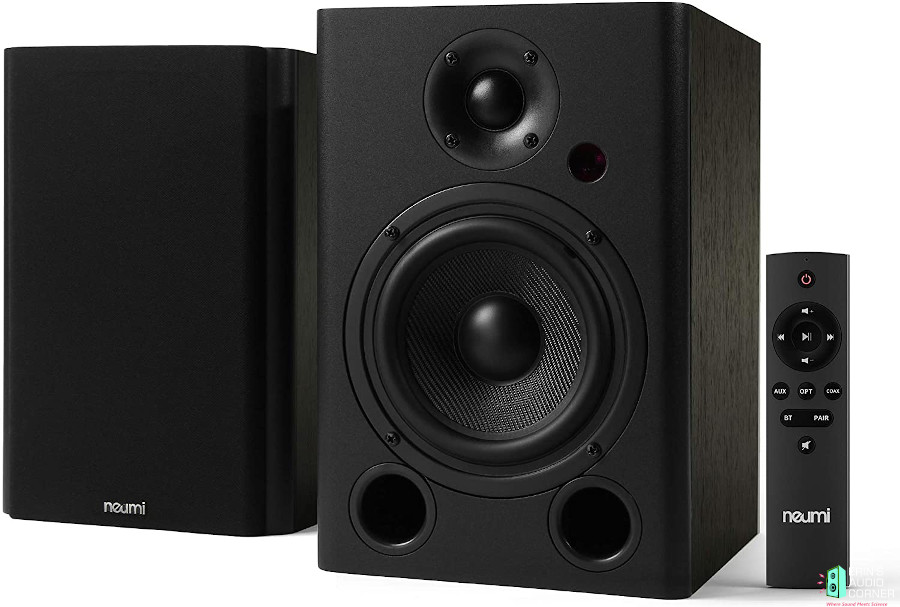Foreword / YouTube Video Review
I reviewed the Neumi BS5P in April 2021 and was very disappointed with the results. The manufacturer contacted me about the results and also expressed their dismay because it was nothing like what they had predicted. This review is an update based on some firmware changes and findings through working with Neumi to understand why my production unit was so far off from their intent.
The review on this website is a brief overview and summary of the objective performance of this speaker. It is not intended to be a deep dive. Moreso, this is information for those who prefer “just the facts” and prefer to have the data without the filler.
However, for those who want more - a detailed explanation of the objective performance, and my subjective evaluation (what I heard, what I liked, etc.) - please watch the below video where I go more in-depth.
Re-Review Backstory
As I said in the Foreword, this is review is based upon some poor results from my initial testing of this speaker. Neumi contacted me about the results (without ever questioning the legitimacy of said results) and asked if I would be willing to check the tweeter polarity to make sure it wasn’t wired out of phase. Turned out the tweeter was indeed wired out of phase. Neumi was very earnest about resolving the issue and sent me an email with the following information:
We’ve tested through speakers we pulled back from Amazon’s warehouse and did not find any units with a reversed tweeter. We also did FR sweeps and they were all within a tight group above 1kHz. So if the speaker you test does have a reversed tweeter, we are more confident now that it’s an isolated incident.
Easy fix; flip the polarity. Yet, the end result still wasn’t what I thought was up to snuff. So, Neumi gave me some backstory on what they were looking to achieve and asked if I would be interesting in trying out some DSP updates and I said of course. Now, I realize it may sound as if I am going too far for a manufacturer to resolve issues. I get it. However, when a manufacturer is willing to take criticism and use that to make improvements then I feel it is worthwhile to work with them to resolve the issues. Especially when I feel the product could easily be taken from a terrible item to a great performer and at such a reasonable entry price as to get the consumer a better value than I feel is currently available otherwise. This is such a case.
Neumi then let me know they made some updates to their built-in EQ and provided me a link to their website for download and instructions on how to update the firmware. Here is the link. So, now I was left with three EQ options:
- Factory EQ (dated 09-09-2020)
- Flat EQ (all internal EQ disabled)
- Updated EQ (dated 05-04-2021)
Information and Photos
Note: Neumi sent me this speaker to test. I was not paid for this review nor has Neumi seen this review before publication.
The Neumi BS5P is a powered 2-way Studio Monitor featuring a 5-inch midwoofer and 1-inch dome tweeter. It comes with a variety of hookup options (Bluetooth, optical toslink, and RCA connections. It also comes with a remote control.
MSRP is about $150 USD for a pair.
And here are some specs copied from the manual:
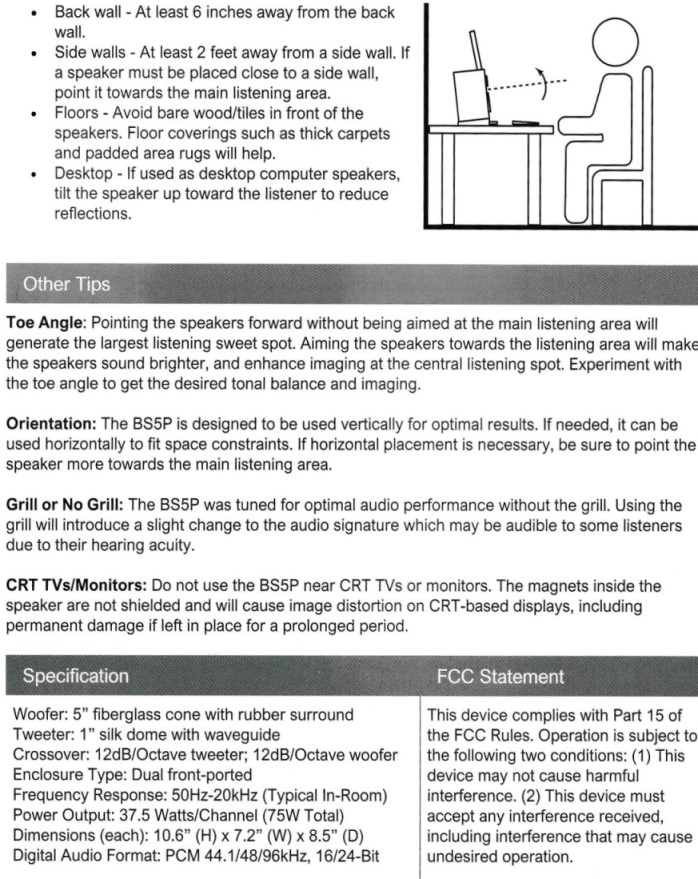
The front can be covered with a grille. The back features various inputs as well as buttons for power, source selection and volume/track selection. And a remote is also included.
CTA-2034 (SPINORAMA) and Accompanying Data
All data collected using Klippel’s Near-Field Scanner. The Near-Field-Scanner 3D (NFS) offers a fully automated acoustic measurement of direct sound radiated from the source under test. The radiated sound is determined in any desired distance and angle in the 3D space outside the scanning surface. Directivity, sound power, SPL response and many more key figures are obtained for any kind of loudspeaker and audio system in near field applications (e.g. studio monitors, mobile devices) as well as far field applications (e.g. professional audio systems). Utilizing a minimum of measurement points, a comprehensive data set is generated containing the loudspeaker’s high resolution, free field sound radiation in the near and far field. For a detailed explanation of how the NFS works and the science behind it, please watch the below discussion with designer Christian Bellmann:
A picture of the setup in my garage:
The reference plane in this test is just below the tweeter, per the manufacturer. A single RCA input was used and the volume was set to default. No grille was used.
Measurements are provided in a format in accordance with the Standard Method of Measurement for In-Home Loudspeakers (ANSI/CTA-2034-A R-2020). For more information, please see this link.
This test will consist of the following four (4) SPINORAMA cases and then I’ll provide more in-depth results of the fourth option. Read the titles of the graphics to know what case you’re looking at. All, of course, have the corrected tweeter polarity.
- Factory EQ (dated 09-09-2020)
- Flat EQ (all internal EQ disabled)
- Updated EQ (dated 05-04-2021)
- Number 3 above, with stuffed ports
The fourth option, above, provides the best overall response and one that is much more pleasing to my ears. Therefore, the majority of my review is based on this particular option (updated EQ and ports stuffed).
I used some eggcrate foam and stuffed it into the ports as shown below. Classy!
CTA-2034 / SPINORAMA:
The On-axis Frequency Response (0°) is the universal starting point and in many situations, it is a fair representation of the first sound to arrive at a listener’s ears.
The Listening Window is a spatial average of the nine amplitude responses in the ±10º vertical and ±30º horizontal angular range. This encompasses those listeners who sit within a typical home theater audience, as well as those who disregard the normal rules when listening alone.
The Early Reflections curve is an estimate of all single-bounce, first-reflections, in a typical listening room.
Sound Power represents all the sounds arriving at the listening position after any number of reflections from any direction. It is the weighted rms average of all 70 measurements, with individual measurements weighted according to the portion of the spherical surface that they represent.
Sound Power Directivity Index (SPDI): In this standard the SPDI is defined as the difference between the listening window curve and the sound power curve.
Early Reflections Directivity Index (EPDI): is defined as the difference between the listening window curve and the early reflections curve. In small rooms, early reflections figure prominently in what is measured and heard in the room so this curve may provide insights into potential sound quality.


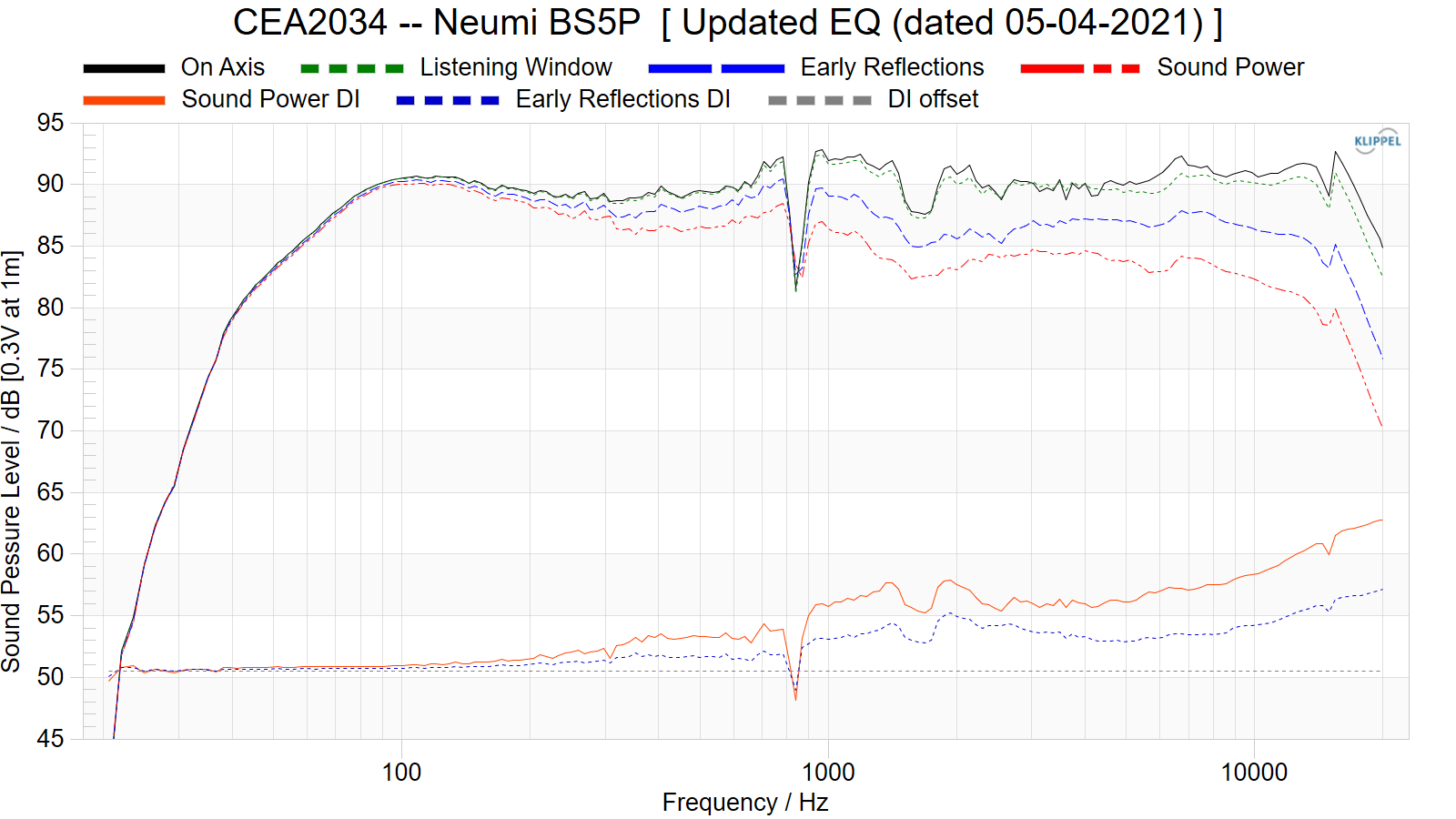

The fourth option, above, provides the best overall response and one that is much more pleasing to my ears. Therefore, the majority of my review is based on this particular option (updated EQ and ports stuffed).
Early Reflections Breakout:
Floor bounce: average of 20º, 30º, 40º down
Ceiling bounce: average of 40º, 50º, 60º up
Front wall bounce: average of 0º, ± 10º, ± 20º, ± 30º horizontal
Side wall bounces: average of ± 40º, ± 50º, ± 60º, ± 70º, ± 80º horizontal
Rear wall bounces: average of 180º, ± 90º horizontal

Estimated In-Room Response:
In theory, with complete 360-degree anechoic data on a loudspeaker and sufficient acoustical and geometrical data on the listening room and its layout it would be possible to estimate with good precision what would be measured by an omnidirectional microphone located in the listening area of that room. By making some simplifying assumptions about the listening space, the data set described above permits a usefully accurate preview of how a given loudspeaker might perform in a typical domestic listening room. Obviously, there are no guarantees because individual rooms can be acoustically aberrant. Sometimes rooms are excessively reflective (“live”) as happens in certain hot, humid climates, with certain styles of interior décor and in under-furnished rooms. Sometimes rooms are excessively “dead” as in other styles of décor and in some custom home theaters where acoustical treatment has been used excessively. This form of post processing is offered only as an estimate of what might happen in a domestic living space with carpet on the floor and a “normal” amount of seating, drapes, and cabinetry.
For these limited circumstances it has been found that a usefully accurate Predicted In-Room (PIR) amplitude response, also known as a “room curve” is obtained by a weighted average consisting of 12 % listening window, 44 % early reflections and 44 % sound power. At very high frequencies errors can creep in because of excessive absorption, microphone directivity, and room geometry. These discrepancies are not considered to be of great importance.

Horizontal Frequency Response (0° to ±90°):

Vertical Frequency Response (0° to ±40°):

Horizontal Contour Plot (not normalized):
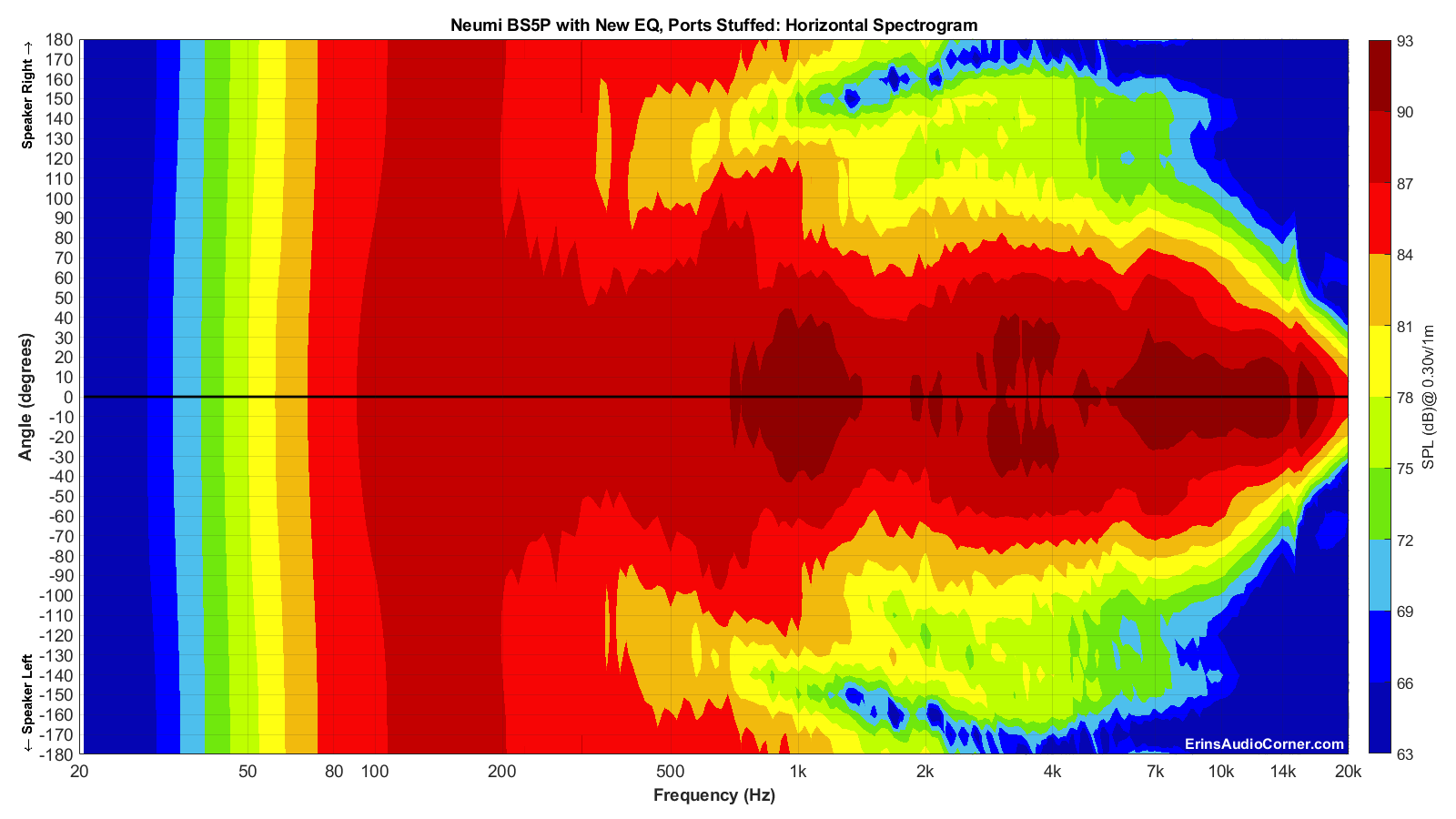
Horizontal Contour Plot (normalized):
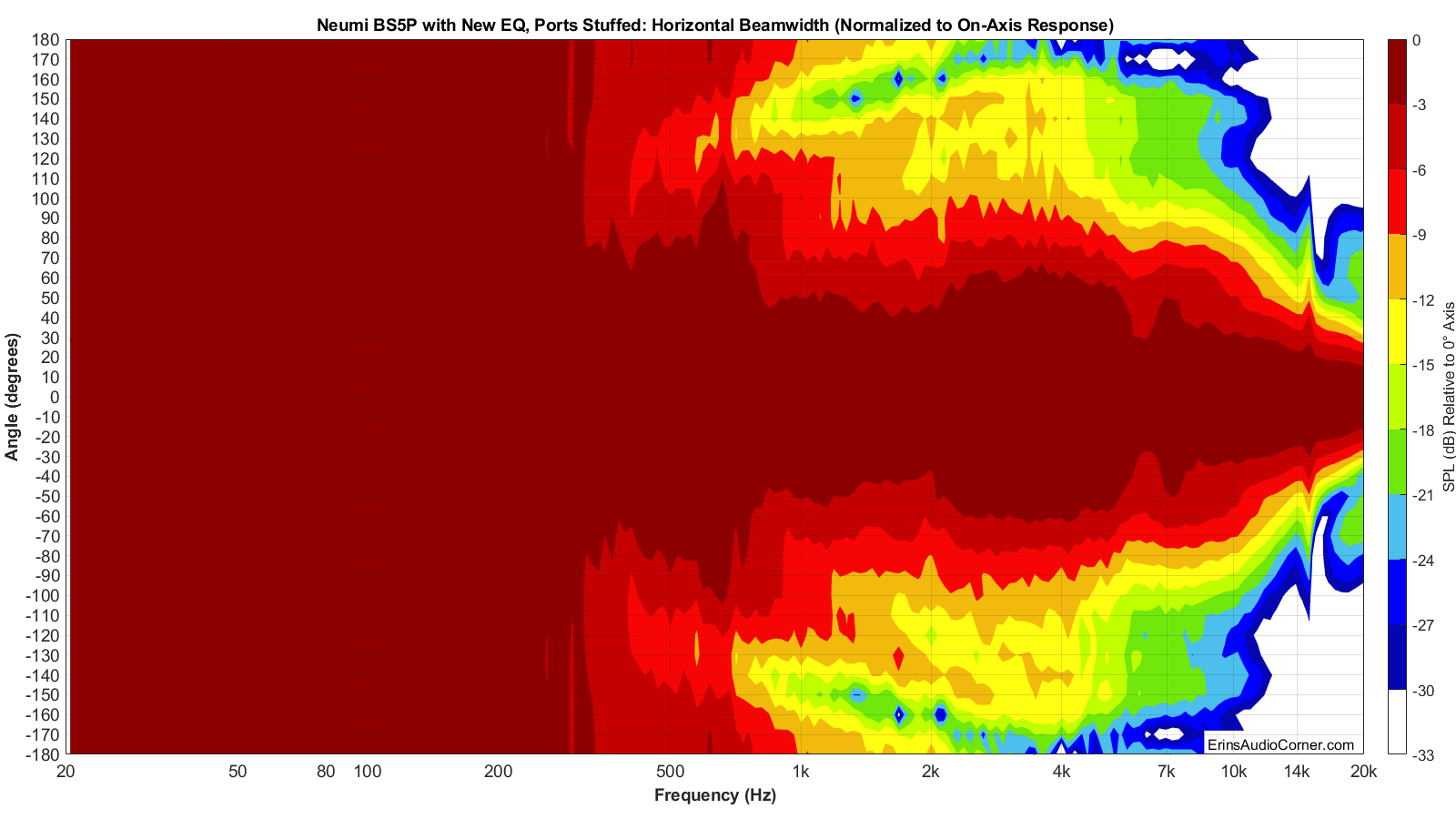
Vertical Contour Plot (not normalized):
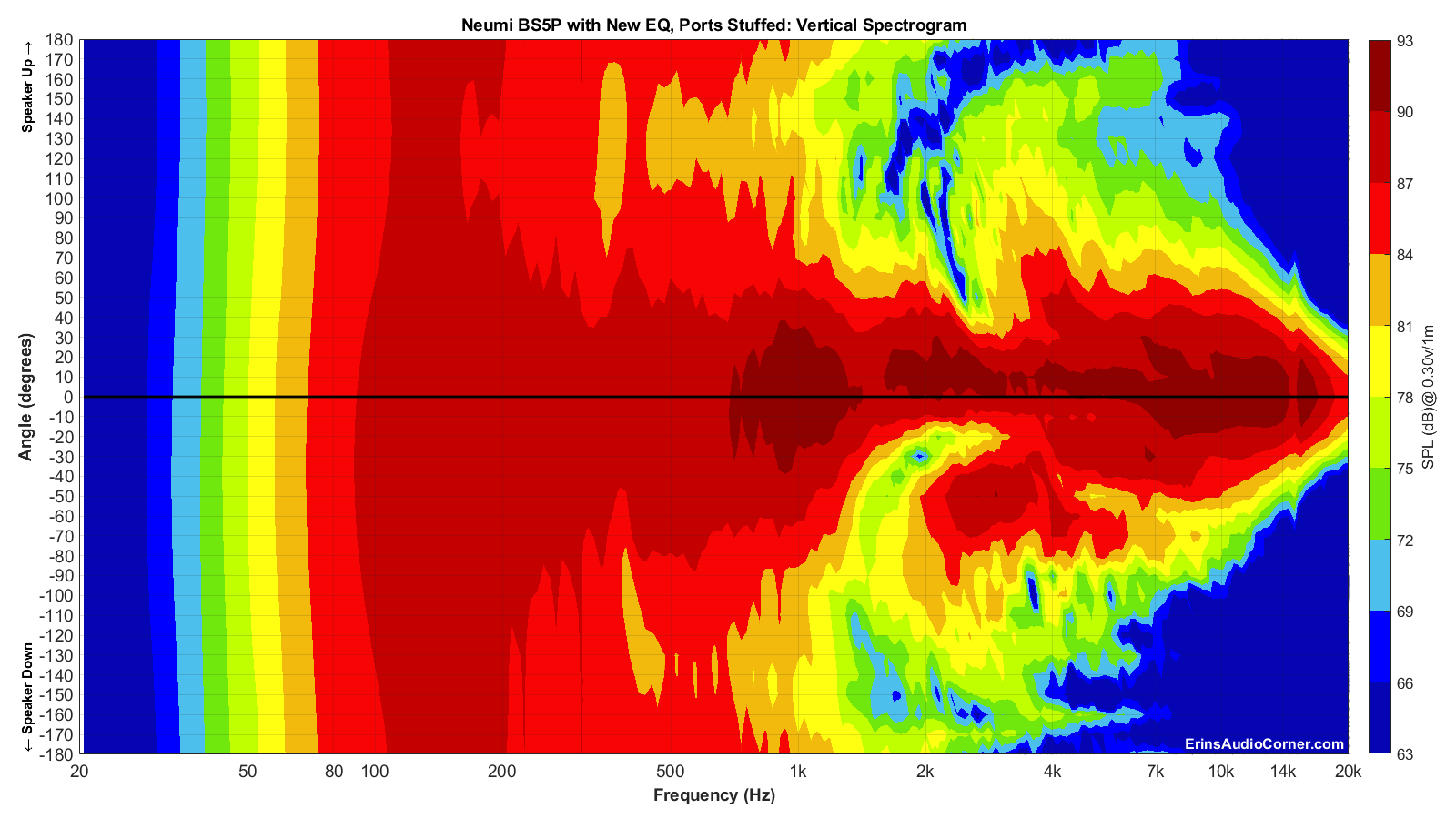
Vertical Contour Plot (normalized):

Additional Measurements
On-Axis Response Linearity
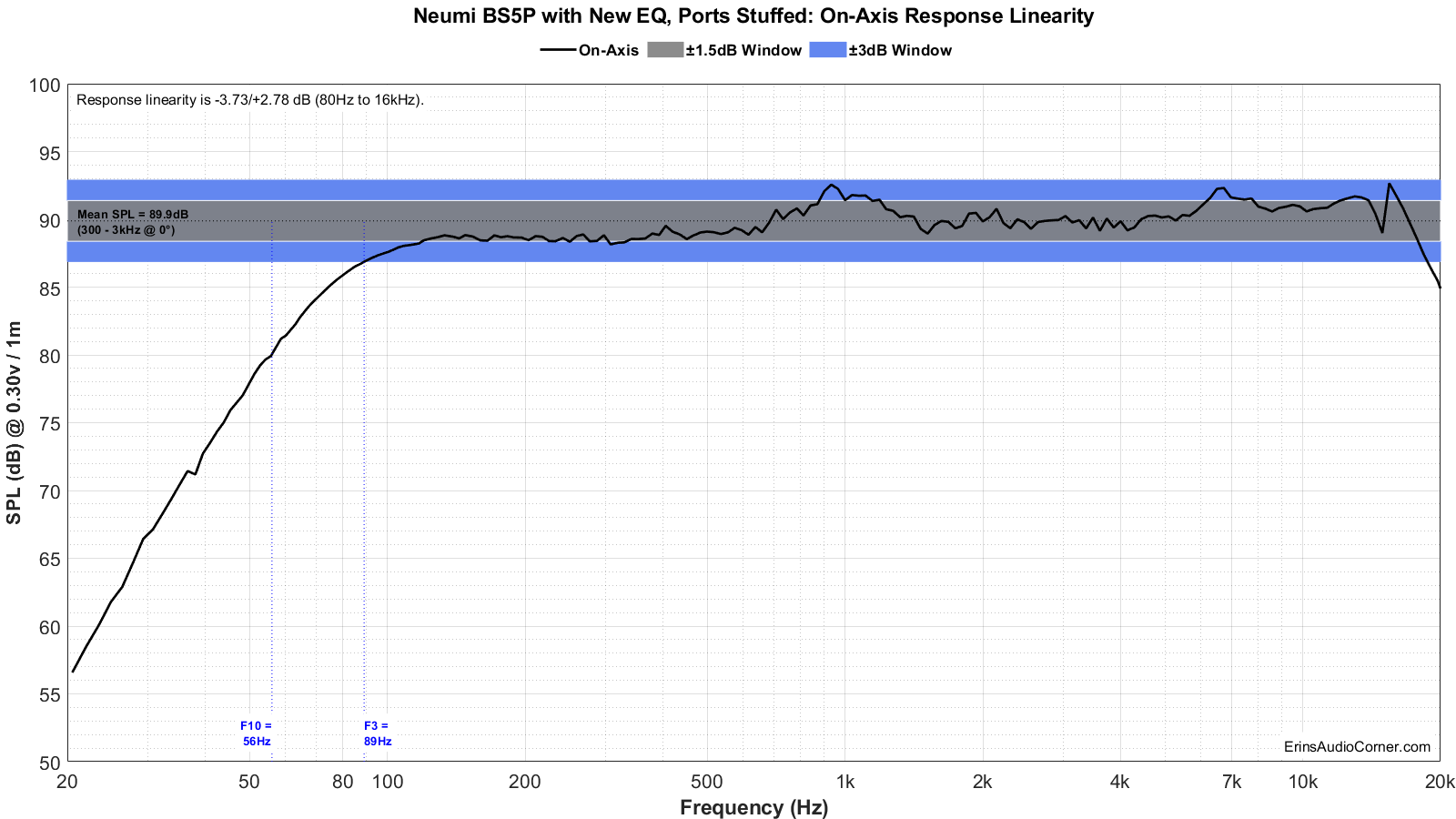
“Globe” Plots
These plots are generated from exporting the Klippel data to text files. I then process that data with my own MATLAB script to provide what you see. These are not part of any software packages and are unique to my tests.
Horizontal Polar (Globe) Plot:
This represents the sound field at 2 meters - above 200Hz - per the legend in the upper left.

Vertical Polar (Globe) Plot:
This represents the sound field at 2 meters - above 200Hz - per the legend in the upper left.

Harmonic Distortion
Harmonic Distortion at 86dB @ 1m:
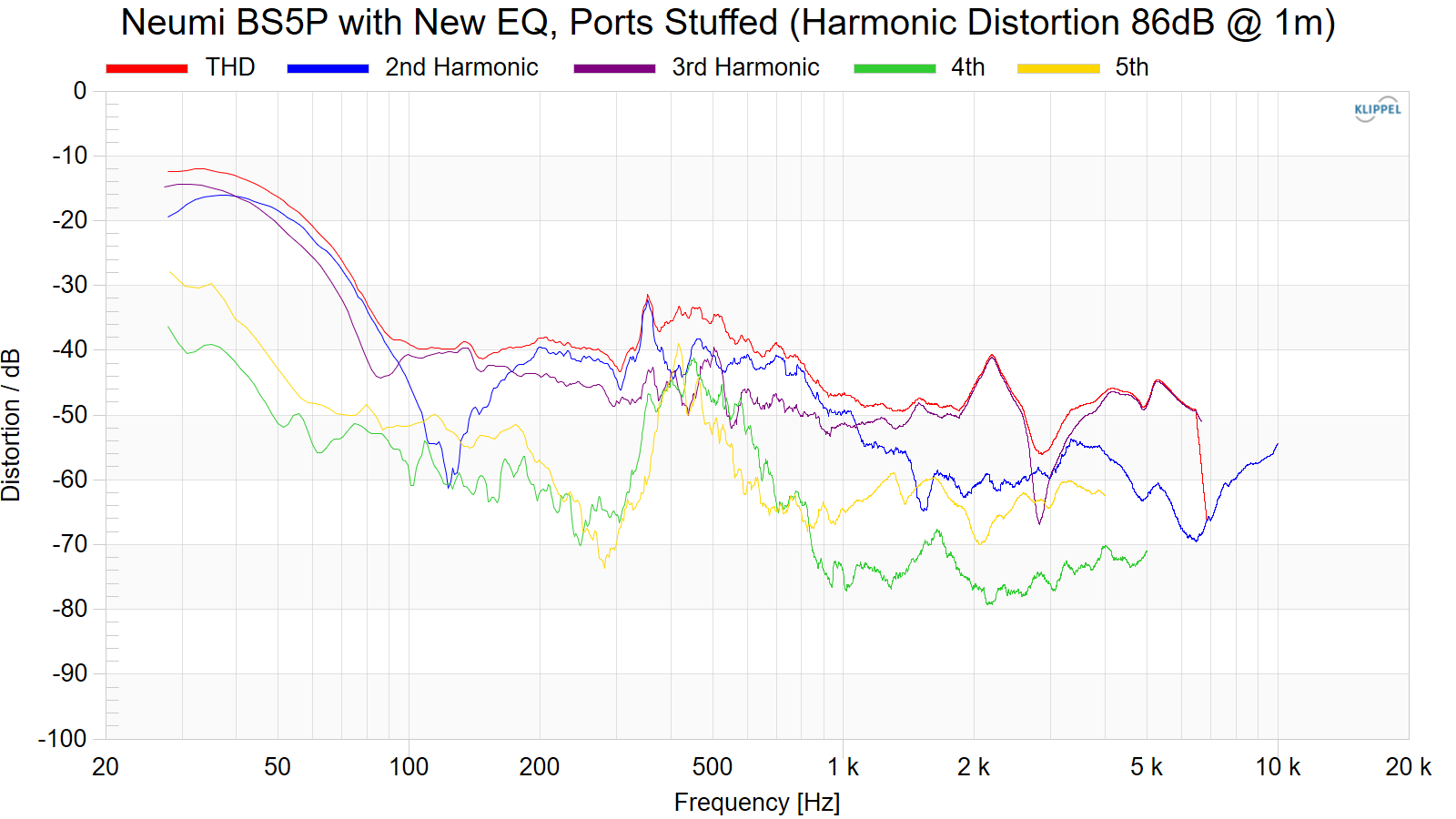
Harmonic Distortion at 96dB @ 1m:
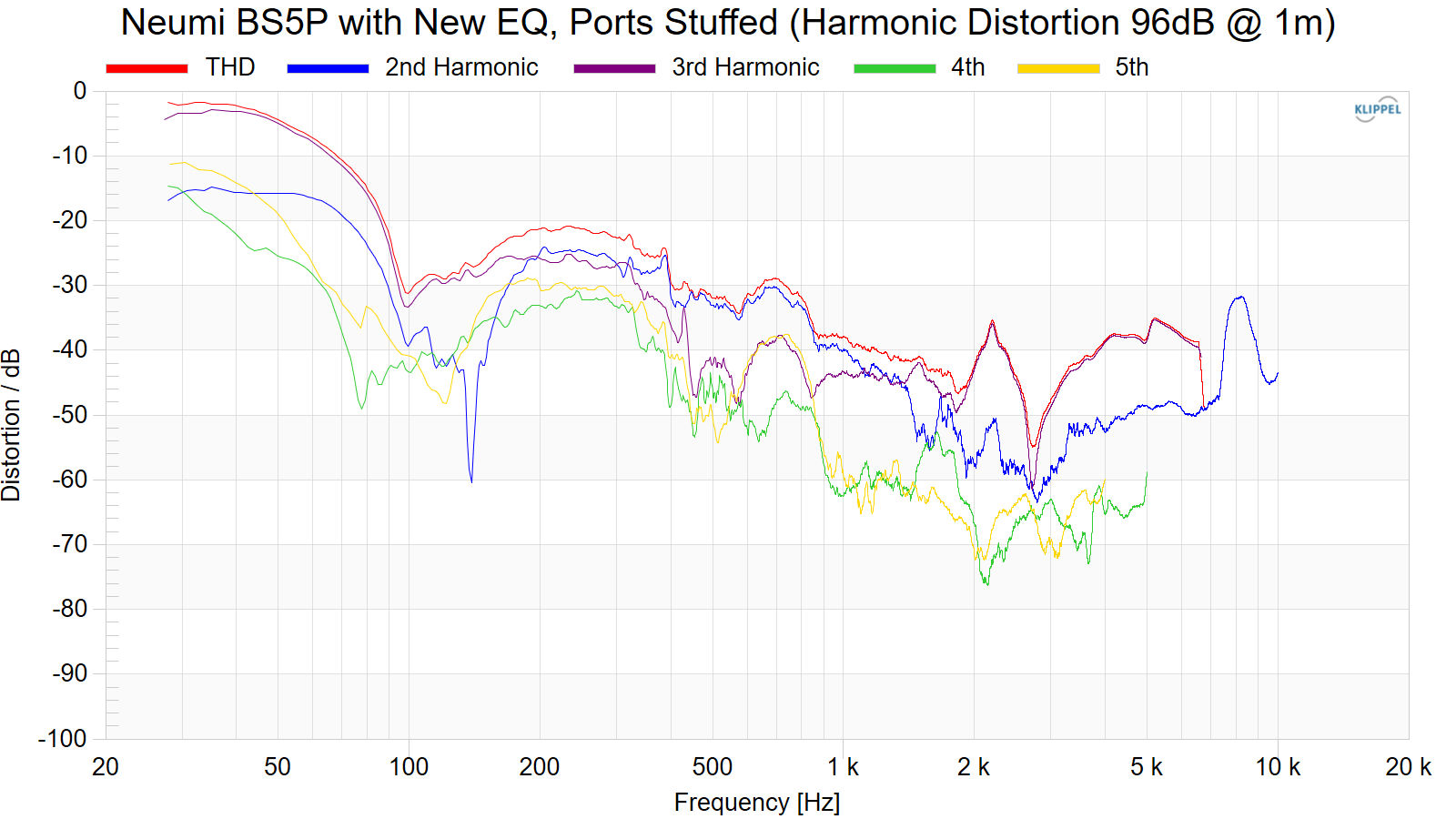
Near-Field Response
Nearfield response of individual drive units:

Dynamic Range (Instantaneous Compression Test)
I simply forgot this test but if you are interested, please see previous test’s results.
Long Term Compression Tests
The below graphics indicate how much SPL is lost or gained in the long-term as a speaker plays at the same output level for 2 minutes, in intervals. Each graphic represents a different SPL: 86dB and 96dB both at 1 meter.
The purpose of this test is to illustrate how much (if at all) the output changes as a speaker’s components temperature increases (i.e., voice coils, crossover components).
The tests are conducted in this fashion:
- “Cold” logarithmic sine sweep (no stimulus applied beforehand)
- Multitone stimulus played at desired SPL/distance for 2 minutes; intended to represent music signal
- Interim logarithmic sine sweep (no stimulus applied beforehand) (Red in graphic)
- Multitone stimulus played at desired SPL/distance for 2 minutes; intended to represent music signal
- Final logarithmic sine sweep (no stimulus applied beforehand) (Blue in graphic)
The red and blue lines represent changes in the output compared to the initial “cold” test.
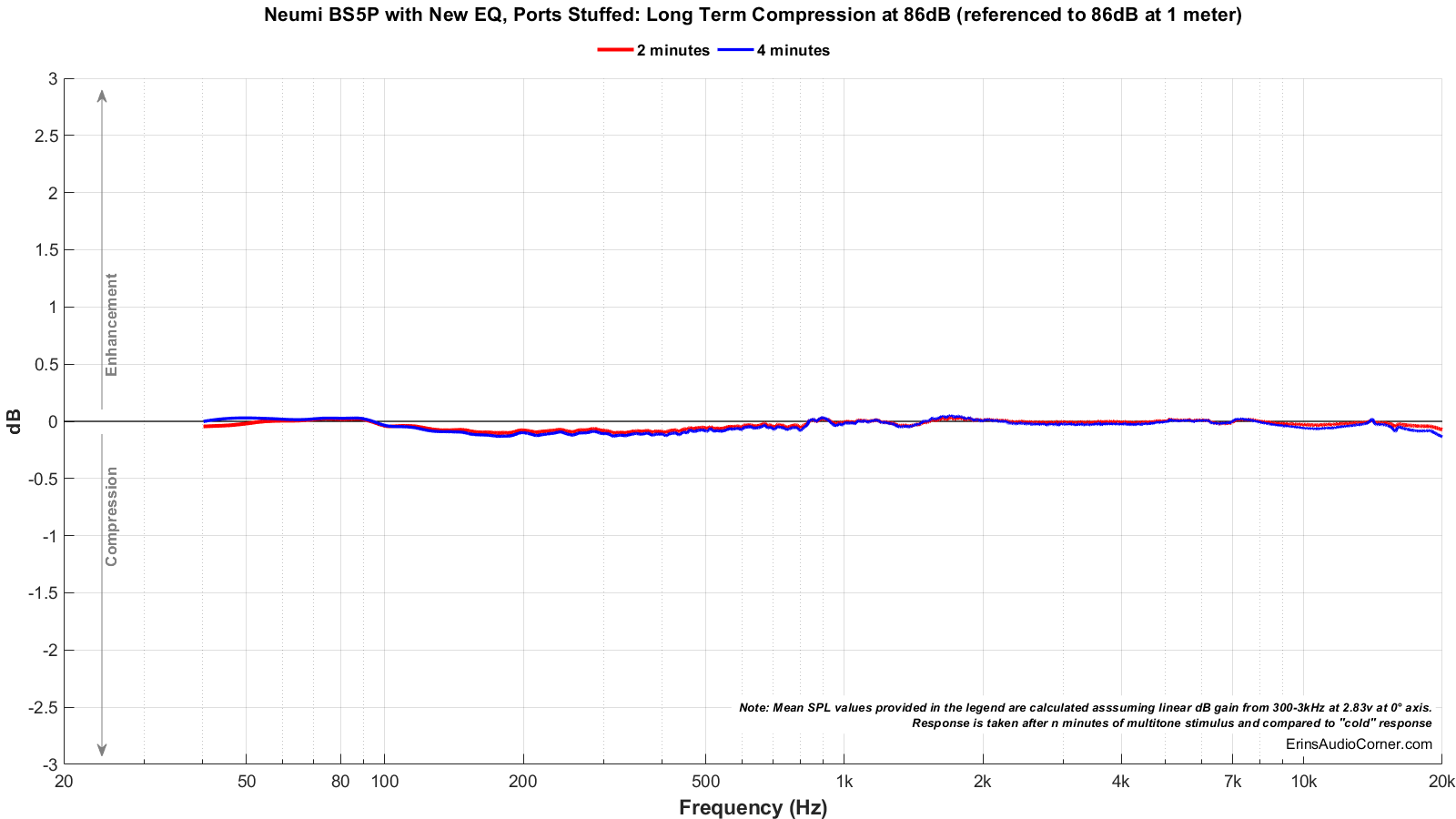
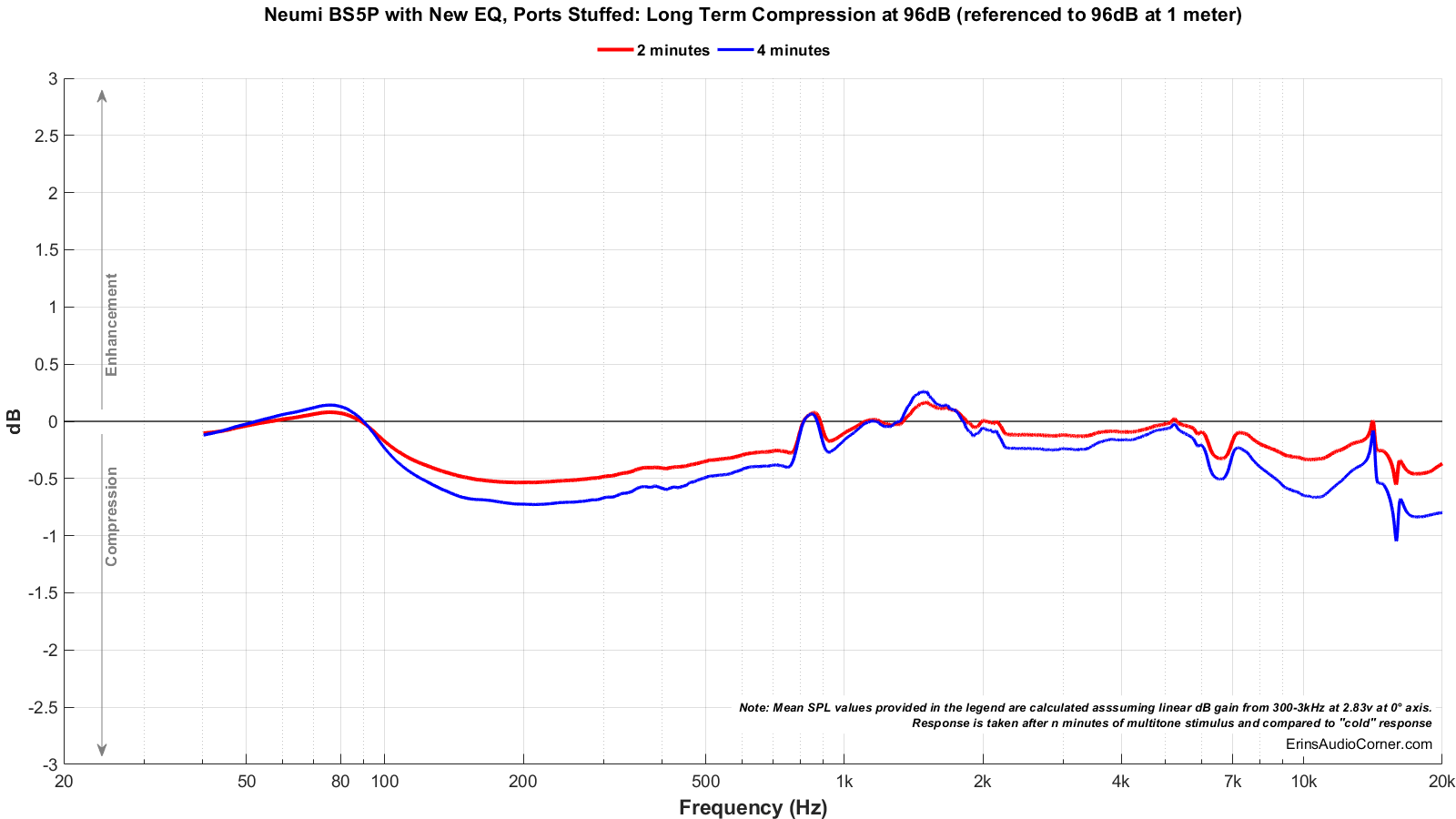
Parting / Random Thoughts
If you want to see the music I use for evaluating speakers subjectively, see my Spotify playlist.
- Subjective listening was mainly in the nearfield to midfield, between 1 to 2 meters. Subjective listening was conducted at 80-95dB at these distances. Higher volumes were done simply to test the output capability in case one wants to try to sit further away.
- With the speaker tested in the configuration discussed (again, Updated EQ, ports stuffed), this is an entirely different ballgame than with my previous testing. I mean, night and day. The midrange is so much more neutral (great track: Wishing Well by Terence Trent D’Arby). The response is much more neutral and doesn’t call attention to itself nearly. Gone is the bloated bass and the sharp treble. What you are left with is a reasonably neutral response with a lot of input options at a very low cost.
- These speakers exhibit an audible compression when played above about 90dB at a couple meters away. Therefore, they are best used in the near/midfield and not ideal for a large home theater setting, even if you plan to use a subwoofer.
- I highly recommend using the EQ settings available from Neumi’s website linked in the opening of this review and stuffing the ports. This yields a much more neutral response that, in my humble opinion, represents the best value powered bookshelf speaker currently available at only $150, providing a multitude of input options and volume levels that would be reasonable for near and mid-field listening (note: not farfield listening at high SPL).
Bottom line is I can now proudly recommend these speakers with the aforementioned settings. With these settings, they still aren’t without issues but I truly feel they represent an excellent value at only $150. If you are interested in purchasing these speakers, please consider using my Amazon affiliate link below.
Ultimately, if you update the firmware for the new EQ settings and stuff the port, you are left with a very capable speaker for reasonable volume levels and a lot of input options. Could this be a perfect option to use in lieu of a soundbar or hi-fi on a budget? I think so. Pair it with a subwoofer and you’re in business!
As stated in the Foreword, this written review is purposely a cliff’s notes version. For more details about the performance (objectively and subjectively) please watch the YouTube video.
DSP suggestions
I ran the on-axis response through REW’s automatic EQ generation with a flatness target of ±2dB and came up with the following:
- Frequency = 1kHz, Gain = -3dB, Q = 2.373
- Frequency = 6.78kHz, Gain = -2.4dB, Q = 2.472
- Frequency = 13.38kHz, Gain = -2.2dB, Q = 1.000
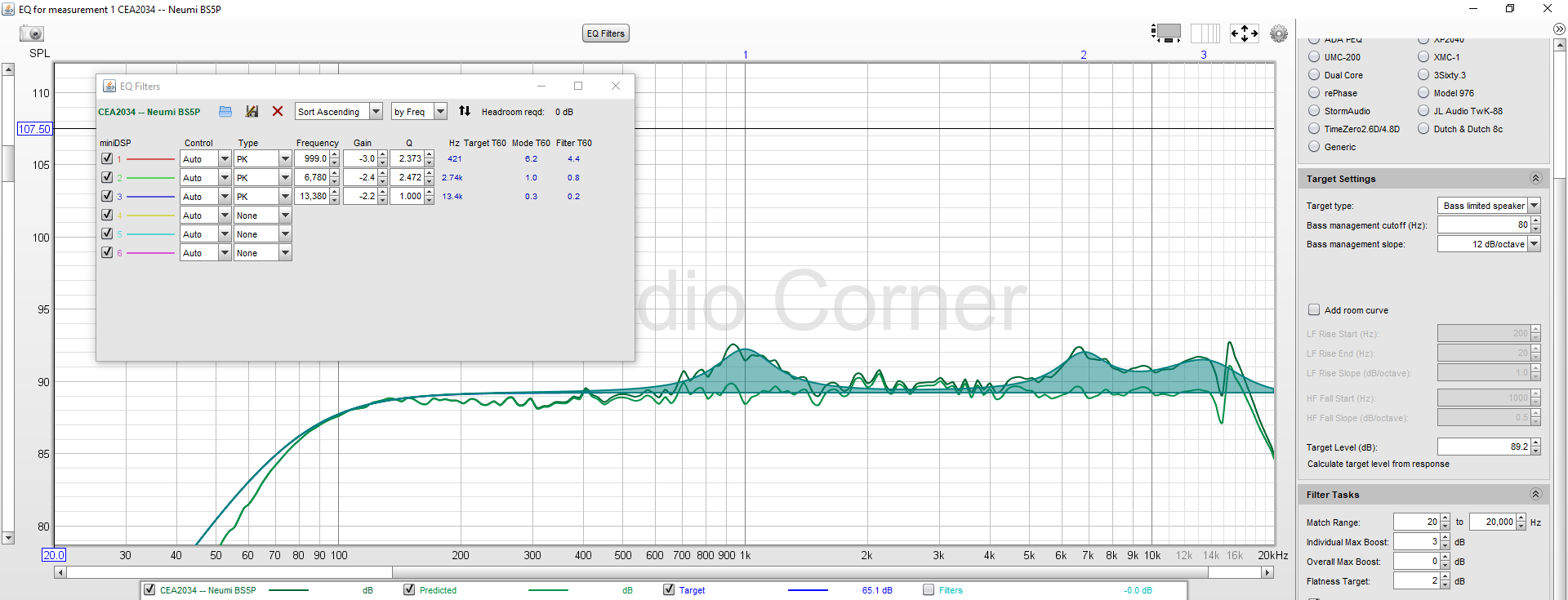
If you have the means, I recommend using EQ to help flatten out the response and achieve a more neutral response, as a set of monitor speakers should provide. If you need help understanding how to use this, I encourage you to check out NoAudiophile’s page here which also has other DSP suggestions for various speakers. It is a great resource for this type of thing.
Support the Cause
If you like what you see here and want to help support the cause you might be interested in joining my Patreon, here. You can also contribute via PayPal (the big yellow button below).
Your support helps me pay for new items to test, hardware, miscellaneous items and costs of the site’s server space and bandwidth. All of which I otherwise pay out of pocket. So, if you can help chip in a few bucks, know that it is very much appreciated.
Alternatively, if you are interested in purchasing these speakers, please consider using my Amazon affiliate link below. It yields me a small commission at no additional cost to you and allows me to keep providing you with sweet data to make educated purchase decisions.
You can also join my Facebook and YouTube pages if you would like to follow along with updates.
